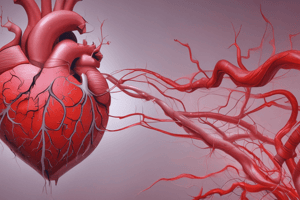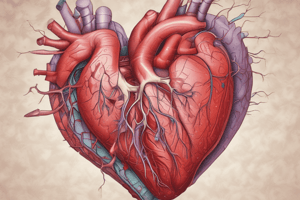Podcast
Questions and Answers
Which of the following correctly sequences the electrical impulse pathway through the heart?
Which of the following correctly sequences the electrical impulse pathway through the heart?
- SA node → AV node → Bundle of His → Bundle branches → Purkinje fibers (correct)
- Purkinje fibers → Bundle branches → Bundle of His → AV node → SA node
- AV node → SA node → Bundle of His → Bundle branches → Purkinje fibers
- SA node → Bundle of His → AV node → Purkinje fibers → Bundle branches
A patient's blood work indicates elevated levels of Troponin I. What does this lab result most likely suggest?
A patient's blood work indicates elevated levels of Troponin I. What does this lab result most likely suggest?
- The patient has a blood infection.
- The patient is at risk for a stroke.
- The patient has experienced myocardial injury. (correct)
- The patient has an electrolyte imbalance.
Which diagnostic test would be most useful in visualizing the blood flow through the coronary arteries?
Which diagnostic test would be most useful in visualizing the blood flow through the coronary arteries?
- Chest radiograph
- Arteriography (correct)
- Electrocardiogram (ECG)
- Echocardiogram
A patient is diagnosed with CAD. The doctor explains that their myocardial oxygen demand is exceeding their myocardial oxygen supply. What condition is the patient experiencing?
A patient is diagnosed with CAD. The doctor explains that their myocardial oxygen demand is exceeding their myocardial oxygen supply. What condition is the patient experiencing?
Which of the following is a modifiable risk factor for coronary artery disease (CAD)?
Which of the following is a modifiable risk factor for coronary artery disease (CAD)?
A patient with a family history of CAD is concerned about their risk. What dietary recommendation is most appropriate to reduce their modifiable risks?
A patient with a family history of CAD is concerned about their risk. What dietary recommendation is most appropriate to reduce their modifiable risks?
Which of the following best describes the function of the coronary arteries?
Which of the following best describes the function of the coronary arteries?
A patient is scheduled for a cardiac catheterization. Which of the following explanations best describes the purpose of this procedure?
A patient is scheduled for a cardiac catheterization. Which of the following explanations best describes the purpose of this procedure?
A patient with angina pectoris is preparing for a walk. Which action demonstrates that the patient understands the teaching to minimize anginal pain?
A patient with angina pectoris is preparing for a walk. Which action demonstrates that the patient understands the teaching to minimize anginal pain?
A patient is admitted with a suspected MI. Which subjective symptom is the MOST indicative of a myocardial infarction?
A patient is admitted with a suspected MI. Which subjective symptom is the MOST indicative of a myocardial infarction?
A patient is recovering from an MI. Which nursing diagnosis takes highest priority?
A patient is recovering from an MI. Which nursing diagnosis takes highest priority?
What is the primary goal of cardiac rehabilitation services for a patient recovering from a cardiac event?
What is the primary goal of cardiac rehabilitation services for a patient recovering from a cardiac event?
A patient with heart failure (HF) gains 4.4 lb (2 kg) in one day. What does this weight gain MOST likely indicate?
A patient with heart failure (HF) gains 4.4 lb (2 kg) in one day. What does this weight gain MOST likely indicate?
A patient with left ventricular failure is experiencing severe dyspnea. Which assessment finding would the nurse expect?
A patient with left ventricular failure is experiencing severe dyspnea. Which assessment finding would the nurse expect?
Which combination of medications is used to manage heart failure by increasing cardiac efficiency?
Which combination of medications is used to manage heart failure by increasing cardiac efficiency?
A patient with valvular heart disease needs teaching regarding activity limitations. What instruction is MOST appropriate?
A patient with valvular heart disease needs teaching regarding activity limitations. What instruction is MOST appropriate?
A patient is diagnosed with hypertension and is prescribed medication. Which patient statement indicates an understanding of hypertension management?
A patient is diagnosed with hypertension and is prescribed medication. Which patient statement indicates an understanding of hypertension management?
Why is teaching about the hazards of cigarette smoking a primary focus for patients with thromboangiitis obliterans (Buerger disease)?
Why is teaching about the hazards of cigarette smoking a primary focus for patients with thromboangiitis obliterans (Buerger disease)?
Flashcards
Cardiovascular System
Cardiovascular System
Heart, blood vessels, and lymphatic structures.
Heart Chambers
Heart Chambers
Two atria and two ventricles.
coronary arteries
coronary arteries
The vessel that Supplies the heart with nutrition and oxygen.
SA Node
SA Node
Signup and view all the flashcards
Nonmodifiable CAD Risk Factors
Nonmodifiable CAD Risk Factors
Signup and view all the flashcards
Modifiable CAD Risk Factors
Modifiable CAD Risk Factors
Signup and view all the flashcards
Angina
Angina
Signup and view all the flashcards
Troponin I
Troponin I
Signup and view all the flashcards
Angina Pectoris
Angina Pectoris
Signup and view all the flashcards
MI Subjective Data (Patient Symptoms)
MI Subjective Data (Patient Symptoms)
Signup and view all the flashcards
MI Objective Data (Observed Signs)
MI Objective Data (Observed Signs)
Signup and view all the flashcards
Cardiac Rehabilitation
Cardiac Rehabilitation
Signup and view all the flashcards
Heart Failure (HF)
Heart Failure (HF)
Signup and view all the flashcards
Left Ventricular Failure Symptoms
Left Ventricular Failure Symptoms
Signup and view all the flashcards
Right Ventricular Failure Symptoms
Right Ventricular Failure Symptoms
Signup and view all the flashcards
Hypertension Nursing Interventions
Hypertension Nursing Interventions
Signup and view all the flashcards
Aneurysm
Aneurysm
Signup and view all the flashcards
Thrombophlebitis Patient Teaching
Thrombophlebitis Patient Teaching
Signup and view all the flashcards
Study Notes
- The cardiovascular system consists of the heart, blood vessels, and lymphatic structures.
- The cardiovascular system delivers oxygen and nutrients to cells and removes carbon dioxide and waste.
- The heart, a pump the size of a fist, propels blood through the circulatory system.
- The heart has four chambers: two atria and two ventricles.
- The heart receives nutrition and oxygen from two coronary arteries.
- The electrical impulse pathway in the heart:
- Begins at the SA node (pacemaker).
- Travels to the AV node.
- Proceeds to the bundle of His.
- Divides into right and left bundle branches.
- Terminates at the Purkinje fibers.
- Three types of blood vessels carry blood to and from the heart: arteries, veins, and capillaries.
Risk Factors for Coronary Artery Disease (CAD)
- Risk factors are classified as nonmodifiable and modifiable.
Nonmodifiable Risk Factors
- Advancing age
- Male gender
- Black race
- Positive family history of CAD
Modifiable Risk Factors
- Cigarette smoking
- Hyperlipidemia
- Stress
- Obesity
- Sedentary lifestyle
- Hypertension
- High cholesterol and saturated fat diet
Patient Care for Cardiovascular Disorders
- You must understand risk factors and incorporate them into patient teaching.
Diagnostic Tests for Cardiovascular Function
- Chest radiograph
- Arteriography
- Cardiac catheterization
- ECG
- Echocardiogram
- Telemetry
- Stress test
- PET
- Thallium scanning
Laboratory Examinations for Cardiovascular Function
- Blood cultures
- CBC (complete blood count)
- PT (prothrombin time)
- INR (international normalized ratio)
- PTT (partial thromboplastin time)
- ESR (erythrocyte sedimentation rate)
- Serum electrolytes
- Lipids (VLDL, LDL, HDL)
- Triglycerides
- Arterial blood gases
- BNP (B-type natriuretic peptide)
- Serum cardiac markers
- Troponin I is a myocardial muscle protein released after myocardial injury and is useful in diagnosing an MI.
Coronary Artery Disease (CAD)
- CAD includes conditions that obstruct blood flow in the coronary arteries.
- Myocardial ischemia occurs when myocardial oxygen demand exceeds supply, resulting in chest pain or angina.
Patient Teaching for Angina Pectoris
- Take nitroglycerin before exertion.
- Eat small, frequent meals.
- Balance exercise with rest.
- Stop activity at the first sign of chest pain.
- Avoid extreme weather conditions.
- Quit smoking.
- Seek a calm environment.
Myocardial Infarction (MI)
- Subjective data may include:
- Heavy pressure or squeezing in the chest.
- Retrosternal pain radiating to the left arm and jaw.
- Anxiety
- Nausea
- Dyspnea
- Objective data may include:
- Pallor
- Hypertension
- Cardiac rhythm changes
- Vomiting
- Fever
- Diaphoresis
Nursing Diagnoses for MI
- Acute pain
- Ineffective tissue perfusion
- Activity intolerance
- Decreased cardiac output
- Anxiety
- Constipation
Cardiac Rehabilitation
- Cardiac rehabilitation services help patients with heart disease recover faster and return to full and productive lives and improves patient compliance.
Heart Failure (HF)
- HF leads to congestion of the heart, lungs, and systemic circulation due to the heart's inability to pump effectively.
- HF is viewed as a neurohormonal problem that progresses due to chronic release of substances like catecholamines, which can be toxic to the heart.
- 1 L of fluid equals 1 kg (2.2 lb); a weight gain of 2.2 lb signifies a gain of 1 L of body fluid.
Heart Failure Symptoms
- Left ventricular failure:
- Dyspnea
- Cough
- Frothy, blood-tinged sputum
- Pulmonary crackles
- Pulmonary vascular congestion with pleural effusion
- Right ventricular failure:
- Edema in feet, ankles, and sacrum (may progress to thighs and genitalia)
- Liver congestion
- Ascites
- Distended jugular veins
Medical Management of Heart Failure
- Increase cardiac efficiency with digitalis, vasodilators, and ACE inhibitors.
- Administer carvedilol (beta blocker) for mild to moderate HF.
- Lower oxygen requirements through bed rest.
- Provide oxygen therapy if hypoxic.
- Treat edema and pulmonary congestion with diuretics and sodium-restricted diet.
- Weigh daily to monitor fluid retention.
Nursing Interventions for Valvular Heart Disease
- Administer prescribed medications (diuretics, digoxin, antidysrhythmics).
- Monitor I&O and daily weight.
- Auscultate breath sounds and heart sounds.
- Take blood pressure.
- Assess capillary perfusion, pedal pulses, and presence of edema.
Teaching for Valvular Heart Disease
- Dietary management
- Activity limitations
- Antibiotic prophylaxis before invasive procedures
Cardiomyopathy
- Most patients have a severe, progressively deteriorating course, with the majority older than age 55 years dying within 2 years of symptom onset.
Peripheral Vascular Disease (PVD)
- PVD is any abnormal condition affecting blood vessels outside the heart and lymphatic vessels.
- Arteriosclerosis is the underlying problem associated with PVD.
Hypertension
- Hypertension occurs when there is a sustained elevated systolic blood pressure greater than 140 mm Hg and/or sustained elevated diastolic blood pressure of greater than 90 mm Hg on two or more readings.
Nursing Interventions for Hypertension
- Blood pressure management through:
- Patient teaching
- Risk factor recognition
- Drug therapy
- Dietary management
- Exercise
- Stress-reduction techniques
Aneurysm
- An aneurysm is an enlarged, dilated portion of an artery and may be the result of arteriosclerosis, trauma, or a congenital defect.
Thromboangiitis Obliterans (Buerger Disease)
- Teaching for Buerger disease focuses on the hazards of cigarette smoking.
Venous Disorders
- Two major venous disorders are thrombophlebitis and varicose veins.
- Thrombophlebitis may result in calf pain on dorsiflexion of the foot (positive Homans sign), but it appears in only 10% of patients with DVT.
Patient Teaching for Thrombophlebitis
- Avoid prolonged sitting or standing.
- Avoid dehydration.
- Reduce weight if obese.
- Perform dorsiflexion-extension exercises of feet and legs.
- Do not cross legs at the knees.
- Elevate legs when sitting.
Studying That Suits You
Use AI to generate personalized quizzes and flashcards to suit your learning preferences.




